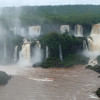Inside the lost cave world of the Amazons

The secret world hidden within the rocky Tapuis mountains are no longer a mystery.
Speleologist Francesco Sauro of the University of Bologna, Italy, along with his team delved into the maze of caves to discover a hidden world which had been untouched for millions of years, reports New Scientist.
The expedition unearthed many unique habitats and explores into the secret world that has evolved in parallel with its surroundings.
Earlier this month, his team finished an arduous, 40-day expedition to some of the world's last unexplored caves inside inaccessible tepuis. His team explored Imawarì Yeuta in Venezuela, which has at least 22 kilometres of tunnels, the largest known cave system of its kind.
The caves are "a completely different world", says Sauro. The quartz walls often have a spooky pinkish hue, and organic acids in the water turn the cave streams red.
The speleothems – stalactites and stalagmites – take fantastic forms. Some resemble billowing clouds of smoke; others look like a spray of mineral mushrooms. Exactly how they form is still a mystery.
Many of the peculiar, lumpy, silica speleothems that only occur inside quartzite caves are formed by colonies of microorganisms working together on the bacterial equivalent of a skyscraper.
Most known caves form in limestone – calcium carbonate – which readily dissolves in water.
But the tepui caves run through quartz sandstone, which is less susceptible to water erosion, so caves form much more slowly. Sauro notes that limestone caves form over hundreds of thousands or a few millions of years; his research suggests quartzite caves form over tens of millions of years.
"We don't have a good idea of how old these caves are," says Jo de Waele, a geographer and cartographer also at the University of Bologna. "There's nothing we can date inside, it's all too old. It's much older than what we expect."

Caves are like nature's treasure chests, says de Waele. "They safeguard material from the outside – there's no wind, no surface erosion," he says. The tepui caves have been protecting their contents for millions of years. "It's incredible."
Sauro says travelling the tepuis' twists and turns is like taking a trip back in time. Each of his expeditions yields new discoveries. In 2012 the team turned up a never-before-identified mineral called rossiantonite. The team has also discovered new species of blind cave fish and bacteria.
Sauro is now focused on better understanding how life evolves in these sunless labyrinths, cut off from the rest of the world. The only way in is via entrances high in the walls or on the mountaintops, which can soar as high as 3000 metres.
The tepuis are isolated by their soaring cliff walls and home to unique species of animals. For example, Mount Roraima tepui is the only known habitat of the Roraima bush toad, a small amphibian that, in the face of danger, curls itself into a ball and rolls away.

The most recent expedition was Sauro's sixth. The team's discoveries won't be released until November, but it's likely they'll be able to introduce the world to another crop of previously unknown species.
Microbes that live in those caves are of special interest, says Hosam Zowawi, a clinical microbiologist from the University of Queensland in Brisbane, Australia, who joined two of the expeditions. "Caves harbour chemical compounds and microbes that we don't know about," he says.
By comparing these "pristine" bacteria to modern superbugs, Zowawi aims to better understand how pathogens develop resistance to antibiotics. "We hope that will widen our gaze about how those bacteria have evolved," he says.
His preliminary analyses have already turned up previously unclassified types of bacteria – but it's too soon to know if they'll be useful.

There's so much left to discover, says Sauro. Not only are quartzite caves and what's hiding inside poorly understood, but individual tepuis can be very different. Each of the hundreds of mountains that dot the landscape developed and evolved independently of the others. "They are like islands in time," he says.
But it won't be easy exploring them. You need a helicopter to get to the top, which depends on it being a clear day with minimal wind – in an area that is typically very cloudy and windy. Expeditions require a lot of money and waiting for near-perfect conditions.
Even once they've disembarked, the explorers often encounter additional challenges. "They have cracks and canyons, and really rough terrain," says Sauro.
He is guided by satellite images that detect cave entrances on tepui tops – but those often end up being blocked by rocks and require a nervy descent on ropes. "On most of them, there's no access without climbing," says Sauro.
But he is undeterred and is already planning the next expedition for later this year.
Source: New Scientist

 For all latest news, follow The Daily Star's Google News channel.
For all latest news, follow The Daily Star's Google News channel. 





Comments